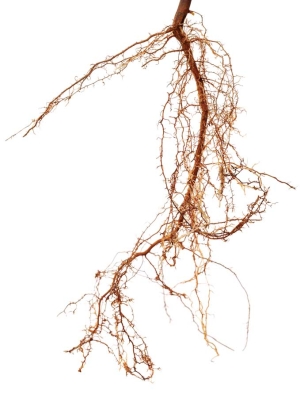
Absorptive roots are responsible for water and nutrient uptake from the soil. Transport roots act like plumbing systems and connect the absorptive roots to the main pioneer roots of the tree. (iStock image)
As growers make decisions about the care and maintenance of fruit trees, they often consider canopies, blossoms, buds, leaves and, of course, fruit. But what about the care and maintenance of roots?
After all, they fulfill some very important functions, says Emily Lavely, a Ph.D candidate in horticulture at Penn State University. “They are necessary for both establishing and anchoring plants and for water and nutrient uptake.”
Lavely works with David Eissenstat, a Penn State professor of woody plant physiology, conducting plant root-microbe studies.
The two made presentations on their research into the roots of fruit trees at February’s Mid-Atlantic Fruit and Vegetable Convention in Hershey, Pennsylvania.
Kinds of roots
There are three kinds of tree roots, said Lavely: absorptive, transport and pioneer roots.
Absorptive roots take up water and nutrients. They are not woody and have a relatively short lifespan, typically from 30 to 60 days. “They are white or lighter in color and the target of microbes and herbivores,” she said.
These lower order roots are the most active absorptive roots because they are where the fastest metabolism occurs.
Owing to their finer structures, they have the greatest amount of soil contact.
Meanwhile, transport roots act like plumbing systems for trees. They move the water and nutrients collected by the absorptive roots. These roots are woody and live for more than one year.
Absorptive roots rarely, if ever, become woody transport roots. Transport roots are initially formed by pioneer roots. As they become woody, they make up the framework supporting the absorptive roots, creating a structure similar to scaffolding branches.
They grow quickly and become woody in weeks. Because pioneer roots develop into woody roots, their lifespan may last as long as the life of the tree.
Root colonization
Most absorptive roots are shallow, located within the top 12 to 15 inches of the soil. “That’s where we apply water and nutrients,” Lavely said.
This is also where a process called mycorrhizal colonization occurs. Mycorrhizae are created by a union of roots and specific soil-born fungi.
They aid in improving plant growth, water and mineral absorption, disease suppression and drought resistance. Mycorrhizal fungi colonize roots faster than non-mycorrhizal fungi. This is especially true for roots aged 15 days or less.
There was no evidence in Lavely’s research that increased carbohydrates increased mycorrhizal colonization of a unit length of root.
A greater amount of carbohydrates below ground more clearly affected root growth than root colonization by microbes. However, once a root was colonized, it was heavily colonized.
Researchers have discovered relationships between root growth and tree fruit loads. “Trees with no fruit have more root growth than trees with fruit,” Lavely said. “They also can have more mycorrhizal root length than trees with fruit.”
Root management
Eissenstat said horticulturalists used to think tree roots only grow during bloom and after harvest seasons.
“Now we know there is no particular evidence they grow within a particular season,” he said. “They can grow at any time during the growing season.”
Lavely thinks growers who wish to focus on root management need to direct their efforts on the growth of healthy absorptive roots. Watering is usually a good idea, except when too much is applied.
“Too much water and too much nitrogen brings on more leaves and less fruit,” Eissenstat said.
The rhizosphere, the soil located near the root structure, is much richer in nutrients consumed by microbes than bulk soil, areas located well away from roots. Some 30 to 40 percent of soil organic matter comes from plant roots.
One way to improve soil conditions may be through the use of organic mulches, Eissenstat said. He favors the use of compost, green manure and other biological waste materials to enhance microbial activity.
Planting cover crops under grapevines and some kinds of fruit trees can also be a good idea for the same reason, but the practice needs to be balanced by limiting competition.
Well-drained soils can also improve populations of mycorrhizal fungi.
Soil stress can affect roots in two ways depending on the magnitude of the stress: It can cause plants to put out more roots or to cease their production altogether.
Growers should be careful not to apply too much nitrogen in the summer, Eissenstat said. Phosphorus is another double-edged fertilizer — too much phosphorus leads to less abundant mycorrhizae.
In addition, broad spectrum insecticide application can cause roots to live longer, but the long-lasting effects of this treatment are unknown, he said.
More research is needed to determine “detailed prescriptions” to improve the rhizosphere. “We know tillage is detrimental because it reduces the interaction between beneficial and nonbeneficial microbes,” Eissenstat said.
He also thinks root pruning is an “iffy” practice. “You can open roots to diseases that way,” he said. “The machinery used to transport the equipment can cause soil compaction.” •
– by Dave Weinstock






Leave A Comment